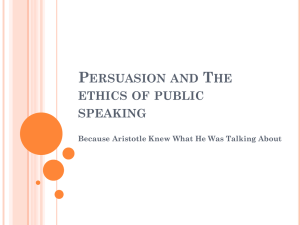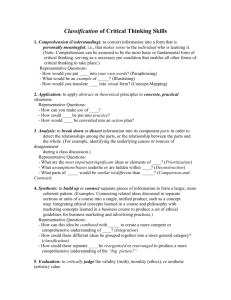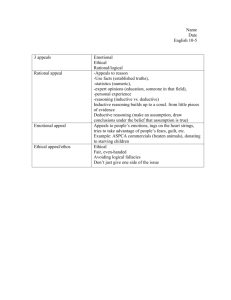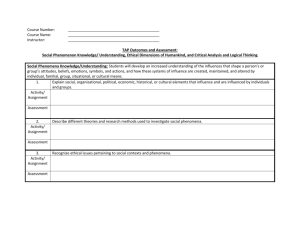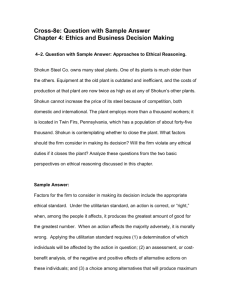Persuasion and Ethics
advertisement
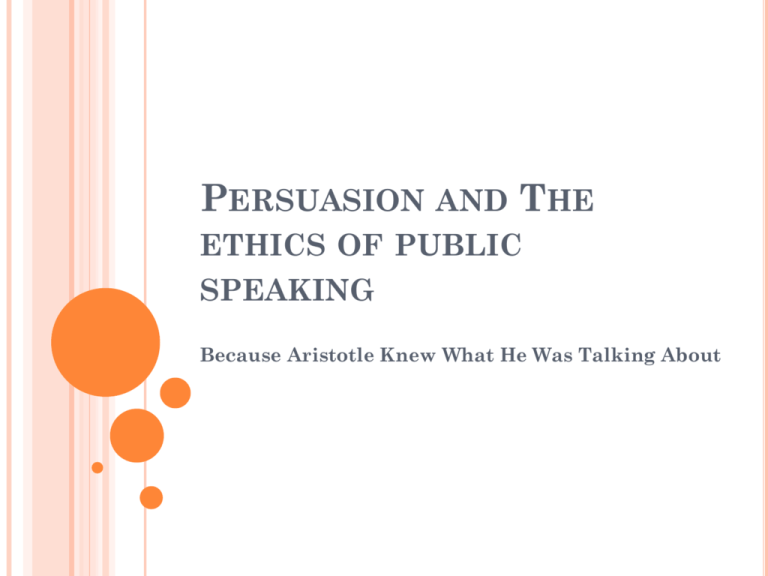
PERSUASION AND THE ETHICS OF PUBLIC SPEAKING Because Aristotle Knew What He Was Talking About PERSUASION Process of changing or reinforcing attitudes, beliefs, values, and behaviors Ethos, Pathos, and Logos Ethos—credibility Pathos—emotional appeal Logos—logical appeal (reasoning & evidence) People will be persuaded by one or more of these reasons QUALITIES OF POSITIVE ETHOS Credibility—whether you are qualified to speak on a given topic Competence Character Establish Credibility Competence—informed, skilled, knowledgeable Trustworthiness—believable and honest Dynamism—energy (charisma) Enhance Credibility Initial Derived Terminal STRENGTHEN YOUR ETHOS Each time you speak, people form impressions of you Share audience concerns Cite reputable experts Use personal experience Be clear and interesting Consider different points of view Deliver with dynamism APPEALING TO EMOTIONS (PATHOS) Fundamental to motivating an audience Never a substitute for logical arguments and available evidence Dimensions of emotion = pleasure, arousal, power Be ethical when using emotion. Use: Concrete examples Emotion-arousing words Visual images to evoke emotion Appropriate metaphors and similes Appropriate fear appeals Appeal to several emotions; hope, pride, courage, etc. ETHICAL CONSIDERATIONS Avoid deception and manipulation Recognize and respect power of emotions Avoid distraction and disorientation Don’t overwhelm audience Use emotional appeals to supplement and complement well-reasoned arguments MORE ETHICAL CONSIDERATIONS Have ethical goals and use ethical means Ethical dilemmas Professional obligations can create A conflict of responsibilities A choice between “the lesser of two evils” Circumstances can create Situations dictate a change Does the end justify the means? ETHICAL GUIDELINES Are your purposes consistent w/ prevailing norms? Would you violate your own ethics by speaking out? Are you willing to stick to your ethical principles? What are the ethical standards? Your basic ethical obligations Tell the truth Take responsibility Avoid plagiarism(!!!) THE ETHICAL SPEAKER Is not expected to be perfectly objective Provides good arguments, sound reasoning and solid evidence Remains open to new information Is well informed and fully prepared Contributes useful presentations BUILDING AN ARGUMENT (LOGOS) Use logic and evidence to persuade Logic—System of rules for making inferences Reasoning—Process of drawing conclusions from evidence Evidence—Facts, examples, statistics, expert opinions Claims Debatable assertion by speaker Takes a side on an issue and invites debate A statement with which you want your audience to agree Types of Claims Fact Value Policy TYPES OF CLAIMS FACT CLAIMS Claims about the truth or falsity of an assertion Involve existence, scope or causality Questions about past / present Predictions of the future Require empirical proof: real examples, statistics, and expert testimony Example: To persuade my audience that William Shakespeare did not write the plays attributed to him. VALUE CLAIMS Claims about the worth, rightness, and morality of an idea or action Involve what we consider good or bad, right or wrong Focus on what we believe to be appropriate, legal, ethical or moral Determine how we should evaluate facts, ideas or actions Example: To persuade my audience that bicycle riding is the ideal form of land transportation. POLICY CLAIM Claim about whether a specific course of action should or should not be taken Determine our future actions Deal with how to solve problems Evaluate options by costs, feasibility, advantages and disadvantages “Should” is either stated or implied Two kinds of policy claims: 1. Speeches to gain passive agreement 2. Speeches to gain immediate action SPEECHES TO GAIN PASSIVE AGREEMENT Goal is to convince audience that a given policy is desirable without encouraging the audience to take action in support of it. Example: To persuade my audience that there should be stricter safety standards on amusement park rides. To persuade my audience that the age for full driving privileges should be raised to 18. SPEECHES TO GAIN IMMEDIATE ACTION Goal is to convince the audience to take action in support of a given policy Examples: To persuade my audience to vote in the next presidential election. (i.e. everyone old enough to vote should vote) To persuade my audience to become literacy tutors. (i.e. you should be a literacy tutor) ACTIVITY Write your topic on a piece of paper Write a policy claim about your topic Be clear about what the audience should understand and/or do at the end of your speech Are you seeking passive agreement or immediate action? This is your plan of action Be prepared to share this with the rest of the class ANALYZING POLICY CLAIMS 1. 2. 3. Need—you must establish that there is a need for change Burden of Proof—your obligation to prove that change is necessary Plan—you must have a plan to solve the problem Practicality—Does your solution solve the problem? Does it create new problems? Has this plan worked elsewhere? How has this plan been implemented elsewhere? REASONABLE ARGUMENTS Qualified at a level appropriate to the strength of the reasoning and evidence behind it Words that indicate our level of confidence Examples: “possibly”, “probably”, or “beyond any doubt” Recognize reservations Exceptions to our claim, or conditions under which we no longer hold the claim “Unless” Evidence Consider the criteria or standards that support your evaluation Reflect on the rules, principles or standards we employ in making judgments Tests: quality, relevancy, amount FORMS OF REASONING INDUCTIVE REASONING Moves from a set of specific examples to a general conclusion A number of representative examples makes the case Claims must be carefully qualified Reservations may be needed Can be strengthened with evidence Example Fact 1: My physical education course last term was easy Fact 2: My roommate’s physical education course was easy Fact 3: My brother’s physical education course was easy Conclusion: Physical education courses are easy DEDUCTIVE REASONING Draws a conclusion about a specific case based on generally accepted premise Usually we reason from qualified premises to probable conclusions Premises are often already accepted by audience Speaker may assume the audience will fill in the missing premise Syllogism is a classic example Example 1. The U.S. Constitution guarantees all U.S. citizens the right to vote 2. Women are U.S. citizens 3. Therefore, the U.S. Constitution guarantees women the right to vote CAUSAL REASONING From effect to cause, or cause to effect At the heart of scientific investigation Rarely simple Reputable sources are important Qualified due to complexity Can be difficult to claim causation Example Drinking soda will make you fat Caution: post hoc, ergo propter hoc ANALOGICAL REASONING What is true in one case will be true in another Literal analogy compares similar examples Figurative analogy is similar to metaphor; rarely proves anything Should be qualified Example If you’re good at racquetball, you’ll be good at PingPong LOGICAL FALLACIES: FAULTY REASONING Causal (post hoc, ergo propter hoc) Bandwagon Fallacy If “everyone” thinks it’s a good idea, then it must be Either/Or Fallacy Just because one event follows another does not mean the two are related Argues that there are only two approaches to solving a problem, thus ignoring the complexity of the issues and other possible solutions (e.g. “it’s either vote for higher property taxes or close the library”) Hasty Generalization Reaches a conclusion from too little/nonexistent evidence (i.e. just because something happens in one case does not mean it will happen in all cases) LOGICAL FALLACIES, CONT. Ad Hominem Red Herring Attacks an issue using irrelevant facts or arguments as distractions Appeal to Misplaced Authority Attacks irrelevant personal characteristics of a person, rather than attacking his or her ideas Relies on celebrated or popular people to endorse an idea, rather than relying on experts Non Sequitur (it does not follow) Your conclusion does not follow from your statement (e.g. “a new parking garage should not be built on campus because the grass on the football field is not well-maintained”)
